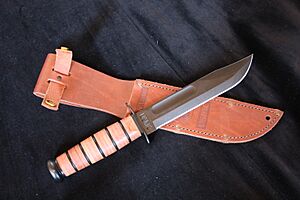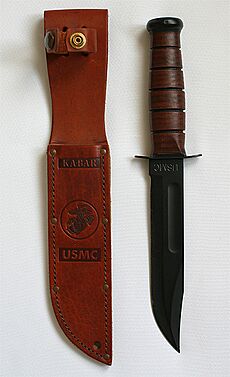Ka-Bar facts for kids
Quick facts for kids (USMC) Knife, Fighting Utility (USN Mark 2 utility knife) |
|
|---|---|

USMC Ka-Bar knife with leather sheath
|
|
| Type | Knife |
| Place of origin | United States |
| Service history | |
| Used by | |
| Wars | |
| Production history | |
| Designed | 23 November 1942 |
| Manufacturer |
|
| Produced | 1943–present |
| Specifications | |
| Mass | 0.7 lb (320 g) |
| Length | 11+7⁄8 in (30.16 cm) |
| Blade length | 7 in (18 cm) |
|
|
|
| Blade type | Clip point |
| Hilt type | Stacked leather washers |
| Scabbard/sheath | Leather (USMC) or plastic (USN) |
The Ka-Bar (pronounced KAY-bar) is a very famous combat knife. It was first used by the United States Marine Corps in November 1942. It was called the 1219C2 combat knife back then. Later, it became known as the USMC Mark 2 combat knife. The United States Navy also started using it as the U.S. Navy utility knife, Mark 2.
Ka-Bar is also the name of the company that makes these knives. Ka-Bar Knives, Inc. is based in Olean, New York. While the company makes many types of knives today, it is most famous for the Ka-Bar Fighting/Utility knife. This knife usually has a 7-inch (17.8 cm) long blade made of strong carbon steel. It also has a special handle made of stacked leather.
Contents
History of the Ka-Bar Knife
Why a New Knife Was Needed
During World War II, American soldiers and Marines needed better knives. They had older knives from World War I. These knives were not very good for fighting or for daily tasks. For example, the Mark I knife was hard to hold and its thin blade broke easily. It was also expensive to make.
The military wanted a new knife that could be used for many things. It needed to be good for fighting and for everyday tasks. It also needed to save metal resources.
Early Attempts and Challenges
The Marine Corps tried a different fighting knife first. It was called the Marine Raider stiletto. This knife was good for stabbing quietly. But Marines found it was not useful for other tasks. It was also too weak for general use, like cutting wire. Many Marines soon traded their stilettos for stronger knives.
Before the Ka-Bar, many Marines bought their own knives. These were often hunting knives with strong blades and leather handles. These personal knives showed what Marines really needed in combat.
Designing the Ka-Bar
To create a better knife, military officials asked several companies for ideas. They looked at the U.S. Navy Mark 1 utility knife and other civilian hunting knives. These were used as a starting point for improvements.
Working with Union Cutlery, Marine Corps officers helped make important changes. They made the blade longer and stronger. They added a small groove to make the blade lighter. The handle was improved with stacked leather for a better grip. The metal parts were also treated to prevent rust and reduce shine.
This new design was called the 1219C2. After many tests, it was approved for use. The Marine Corps officially adopted the knife on November 23, 1942.
Ka-Bar in World War II
The Ka-Bar knife was easy to make. The first knives were shipped on January 27, 1943. The Camillus Cutlery Company was the first and largest maker. The U.S. Navy also started using the Ka-Bar. They called it the US Navy Utility Knife, Mark 2. The Marine Corps renamed it the USMC Mark 2 Combat Knife, or simply the Knife, Fighting Utility.
Marines used the Ka-Bar throughout their forces. It replaced the Marine Raider stiletto, which Marines were happy about. The Ka-Bar was given to special units first. Then, it was given to any Marine who needed one. Even if a knife had "U.S.N. Mark 2" markings, Marines still called it a Ka-Bar.
Marines were taught to use the Ka-Bar for both slashing and utility tasks. This dual-purpose design was very helpful in the jungle fighting of the Pacific. It worked well as a fighting knife and as a tool for daily needs.
After World War II, the U.S. Navy and Marine Corps kept using the Ka-Bar. It also became popular for hunting and general use by civilians.
Who Made the Ka-Bar and Its Name
Original Manufacturers
Many companies made the Ka-Bar knife during World War II. Camillus Cutlery Co. made over one million of them. Other companies included Union Cutlery Co., Robeson (ShurEdge) Cutlery Co., and PAL Cutlery Co.
After the war, other companies like Utica Cutlery Co. and Ontario Knife Co. also made the knife for the U.S. military.
How the Name "Ka-Bar" Started
The company Union Cutlery Co. started using the name KA-BAR in 1923. This name came from a letter they received from a fur trapper. He wrote that he had used the knife to kill a wounded bear that attacked him. His rifle had jammed.
The letter was hard to read, but the words "ka bar" could be seen. It seemed to be part of the phrase "kill a bear." So, in 1923, the company adopted "Ka-Bar" as its trademark. By 1944, Marines started calling the knife a "KA-BAR," no matter which company made it. Because of its popularity, Union Cutlery changed its name to Ka-Bar Cutlery Inc. in 1952.
Ka-Bar Today
Ka-Bar still makes knives for the United States Army, United States Navy, and United States Marine Corps. These versions are very similar to the original Marine knife. They only have small differences in markings on the blade and sheath.
Marines sometimes paint their Ka-Bar blades black. This helps reduce shine and protects the knife from saltwater. The steel used in modern Ka-Bars is very strong. It holds a sharp edge well and is quite hard.
Besides being a fighting knife, the Ka-Bar is still a useful tool. Soldiers use it to open cans, dig small trenches, and cut wood, roots, or wire. In the past, there were versions with stainless steel blades. Today, some models use different types of steel for even better performance.
See also
 In Spanish: Ka-Bar para niños
In Spanish: Ka-Bar para niños
- M3 fighting knife
- OKC-3S bayonet



